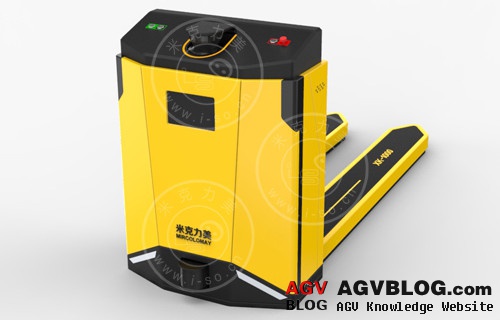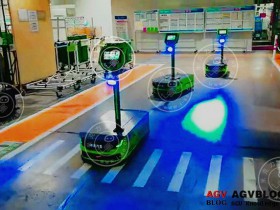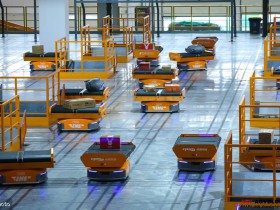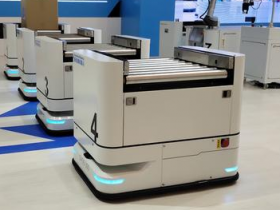Before designing the AGV handling robot, we must first understand the composition of the AGV. A fully functional AGV handling robot system mainly includes mechanical structure, control system, communication system and other parts. Then you need to consider the requirements of the AGV handling robot, know what kind of AGV is needed, and what kind of work to complete, because different uses, the mechanical structure, control method, and working methods of the AGV are different. In addition, the working environment, dimensions, functionality, and navigation methods of the AGV should also be considered. Below, based on years of experience in designing AGVs, Miklimi will share some dry goods with you to let everyone know more about the key points in the design of AGV handling robots.

AGV handling robot
We all know that the normal operation of the AGV ,AGV handling robot is controlled by the central controller. Its main task is to control the start, parking, guidance, speed regulation, path selection, safety monitoring, communication with the host computer, and other equipment of the AGV. Cooperate with loading and unloading materials.
1. AGV handling robot mechanical mechanism
The AGV is generally composed of a walking mechanism, a transplanting mechanism, a vehicle controller, a safety auxiliary device, and a DC battery. The walking mechanism mainly relies on the motor to drive the wheels through the reducer. The transplanting mechanism is selected according to the purpose of the AGV trolley. Commonly used are rollers and manipulators. The on-board controller is responsible for the movement and actions of the entire trolley, including the motor differential and the loading and unloading of the transplanting mechanism. The power supply mostly uses 24V or 48V DC industrial batteries. The drive command is issued by the PLC to control the two servo drives separately, and realize the tracking of the trolley through the electronic differential speed. Different methods can be used for speed adjustment. AGV requires different vehicle speeds when walking in a straight line, turning a corner and approaching a stopping point. The speed of straight-line walking often reaches 0.8m/s~lm/s, and when turning is 0.2m/s~0.3m/ s. It can be said that the mechanical system is the basis of the entire AGV, and the performance of the AGV also largely depends on whether the mechanical system design is reasonable.
2. The structure of the AGV handling robot body
The structure of AGV trolley generally includes three aspects: the number of axles, the driving mode and the steering mode.
(1) Single drive form
The single-drive structure is mostly used in the structure of the tricycle body, which can realize the forward, backward and left-right turning of the AGV trolley (the turning angle is generally less than 90*). The three-wheel structure has good grip and low requirements on the ground. It is mostly used for small AGV handling robots.
(2) Differential drive form
The turning of the car body in the differential form depends on the speed difference between the two active driving wheels, which can realize the forward, backward, left and right turning of the car (the turning angle is greater than 90°), and the spinning in place. The turning effect is better than that of a single drive. Good form.
(3) Double drive form
The dual-drive mode can realize the forward, backward, and all-round steering of the whole vehicle. The main advantage is that it can control any change of the body's posture during the movement. It is mostly used in environments and occasions with small passages or special requirements for working directions. The disadvantage is that the requirements for ground flatness are relatively high, and the adaptability of the car is relatively poor, so it is not suitable for outdoor work and the cost is relatively high.
(4) Multi-wheel drive
Multi-wheel drive is mostly used in eight-wheeled vehicles. The four driving wheels are also steering wheels. The four driven wheels play support and steering functions, which can realize overall forward, backward and omnidirectional driving. It is mostly used in heavy-duty industries and has a relatively structural structure. Complex, difficult to control, and higher cost.
3. AGV handling robot body structure and layout
(1) AGV handling robot body design
The main function of the AGV handling robot body is to support all the mechanical parts and control the original components. The performance should meet the requirements of the car body during operation and acceleration in terms of strength and rigidity. It is usually welded by steel structural parts or steel pipes, and its shell is It is made of thin steel sheet metal, the frame space is directly related to driving and steering, and the placement of heavier parts (such as batteries) is taken into account to facilitate the mechanical structure design and reduce the center of gravity of the car. The lower the center of gravity, the better Conducive to anti-tipping.
(2) AGV handling robot body layout
The battery, motor drive, PLC controller and electrical components are all placed on the frame. The battery is a lead-acid battery and weighs a lot. Considering the weight of the battery, in order to maintain the balance of the body, place the battery on the bottom of the frame. In the middle position, this can ensure the overall balance of the body.
4. Selection of drive motor
Motors are classified according to their working power sources: they can be divided into DC motors and AC motors. AC motors are also divided into single-phase motors and three-phase motors. AGV needs flexible movement, free steering, large working range, and strong adaptability. Therefore, batteries are generally used for power supply, so DC motors are mostly used. Based on the working requirements of our designed AGV, battery power is also used, so a DC motor is selected.
Summary: The design of AGV involves multiple disciplines such as mechanical design, mechatronics, control technology, wireless transmission technology and electronic technology. It is a high-tech product integrating optics, electromechanics, information and computers. The design of Miklimi AGV takes into account the reduction of vehicle weight, lower energy consumption, economy and mechanical control, etc. Miklimi takes powerful and easy-to-use functions as the first design of AGV products, and then talks about reducing costs to ensure Mik Limei AGV is of high quality.




